Teaching your child to ride the bicycle in a quick and easy manner
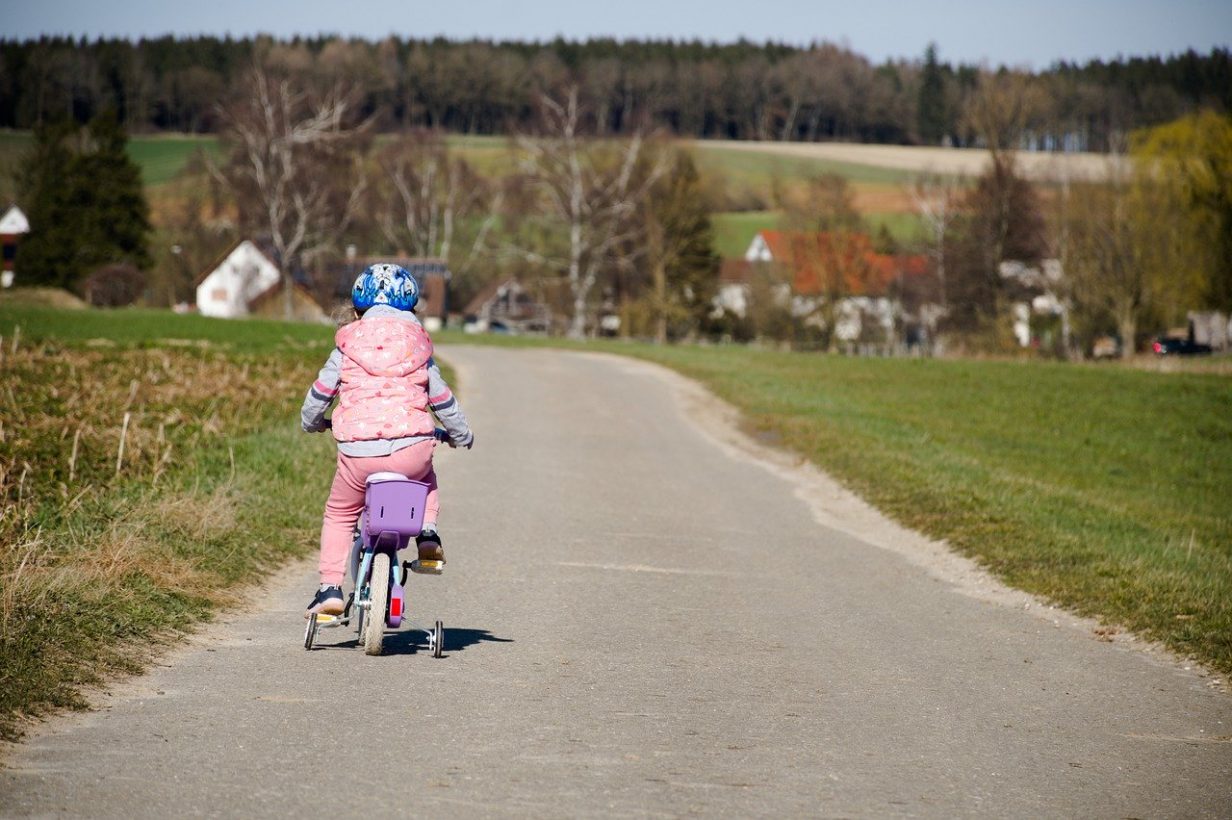
The fresh air, the adrenaline and the interaction with peers – the child will receive all of this when riding a bicycle. Regular rides improve physical and emotional well-being, develop core muscles, and strengthen the cardiovascular and the breathing systems.
This is not just the first means of transportation for the child, but also their two-wheeled companion. As soon as they learn to ride a bicycle, it will accompany them throughout their life. In order to take a sit on the saddle and start pedaling forward, solely maintaining balance is not enough. Think about yourself at this age: you are unlikely to have a quick reaction and to assess the situation on the road. Teaching the child how to ride a bicycle, parents are spared from worrying about their child’s health and safety.
Contents:
- Which age is the best for the child to start learning to ride a bicycle?
- Is it worth buying a three-wheeler bicycle for your child?
- How to teach the child to ride a two-wheel bicycle?
- Are there any alternative teaching methods?
- Where can children of different ages ride?
- Tips for parents
Which age is the best for the child to start learning to ride a bicycle?
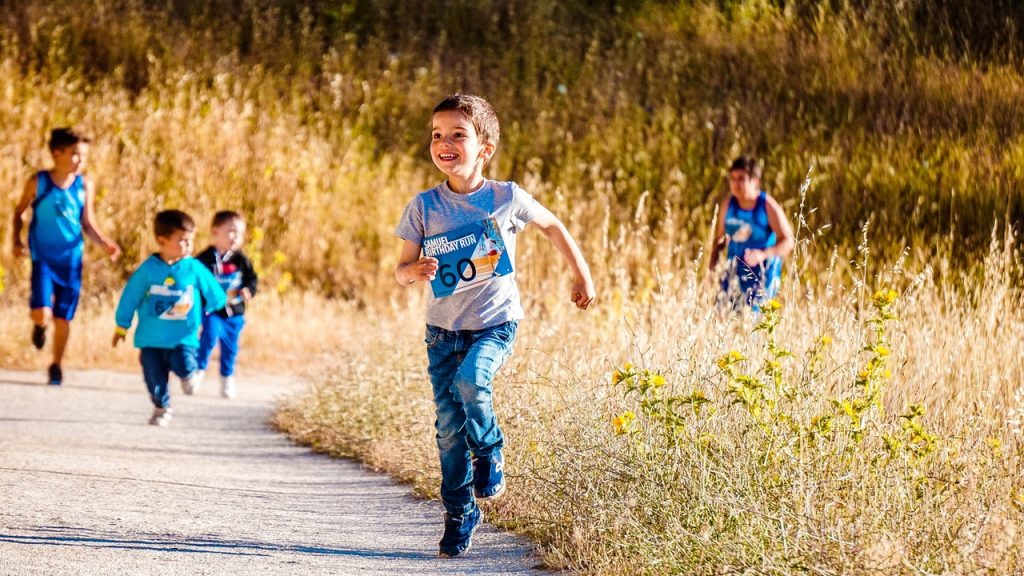
Prostock-studio/Shutterstock.com
Parents are usually divided into two groups of adherents of either early or late education. However, forcing the child and comparing them to their peers is not worth it. It is much easier to teach a child who displays a desire to learn how to ride. A bicycle is chosen not by age, but by height and the level of physical development.
How to select the right bicycle for your child in terms of their height and the wheel diameter? Which models to pay particular attention to? Read about all of these matters in our article In the saddle from the cradle. Choosing the right bicycle for a child.
Children do not display much interest towards balance bikes and bicycles with a parental handle, or the so-called cycle carriages. Such transport is suitable for the youngest children, however, it has nothing in common with autonomous bicycle riding. If a balance bike induces the love for riding, models with a handle for parents, on the contrary, can be off-putting. Children perceive a bicycle with a parental handle as a stroller: on it, they simply sit, look around and do not make any effort to move.
Children start riding a three-wheel bicycle from the age of 1.5-3 years old, and a two-wheeled bicycle with a pair of training wheels – from 5-6 years old. Additional wheels are removed after the child learns to maintain balance.
Is it worth buying a three-wheeler bicycle for your child?
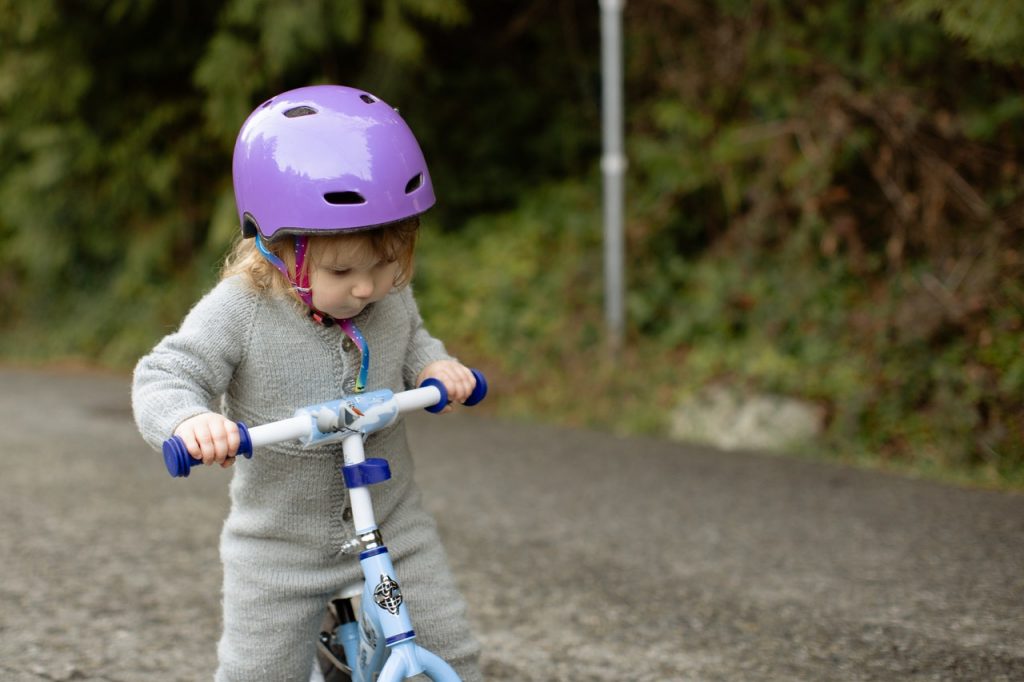
Prostock-studio/Shutterstock.com
Getting on a bicycle and riding without falling off will not be possible. For a five-year-old who has not used such a means of transportation before, it is difficult to master a two-wheeled bicycle. Having learned to ride a three-wheel bicycle, the child will get acquainted with steering the handlebar and will understand the purpose of the pedals and the horn. With such accumulated knowledge, it will be easier for them to shift to a two-wheeled model.
The biggest advantage of the three-wheel bicycle is stability. Children of the age of 2-4 years will find those bicycles comfortable. In addition to that, they will be able to do the following during the ride:
- strengthen the gastrocnemius muscle;
- improve orientation in space;
- work on the vestibular system;
- improve endurance;
- learn better movement coordination.
Cycling improves blood circulation in the body and saturates it with oxygen. This hobby can form the basis of an active lifestyle. The acquired riding skill will not only remain with the child for life but will also bring a great number of positive emotions. American scientists Yingling Fan of the University of Minnesota and Jing Zhu of Northwestern University, have come to the conclusion that a bicycle is the only means of transportation that brings joy during the regular commute to work. In public transportation, people experience stress, and a bike ride before the workday fills them with good energy.
Physical activities in the outdoors will cause a surge in adrenaline levels and the production of endorphins. Riding a bicycle develops determination in the child, which subsequently increases their self-esteem. The novice cyclist will have the opportunity to set and achieve goals. The scope of victory does not matter, what matters is the fact itself. With age, the child will travel around the area, will test themselves at long distances and on difficult terrains.
In the Netherlands, a study was carried out that proved that cycling for 1 hour extends life by an average of the same time. It also was concluded that active cycling extends life by an average of six months in comparison with people who refrain from it.
Tricycle or balance bike – which one is better for the child?
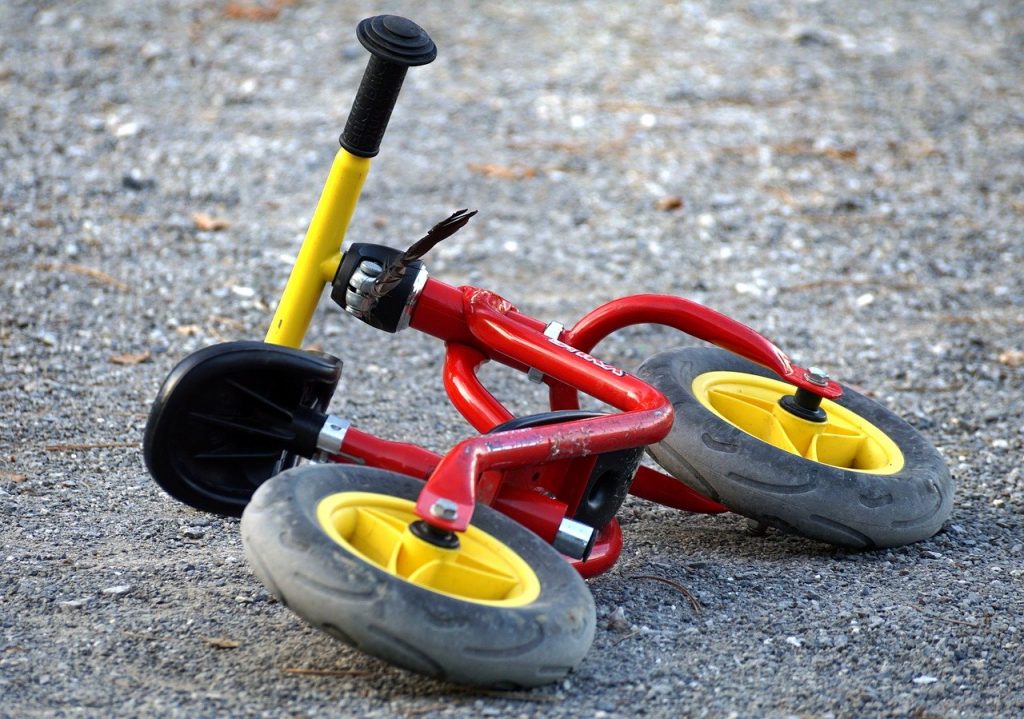
Prostock-studio/Shutterstock.com
Before going on a two-wheeled bicycle, the child should already have some riding experience. Whilst purchasing a tricycle is completely justified, you would have to figure out whether your child needs a balance bike or not.
A balance bicycle is a simplified alternative to the three-wheel bicycle.
It has no transmission and pedals, hence it is more lightweight. It is much easier to master it than to master riding on a bicycle. The child does not need to pedal, keep their balance or be distracted by the noises from the sides. The kid accelerates and brakes by pushing their feet off the ground. During the ride, they will learn to control the direction of their movement.
The advantages of the balance bicycle:
- lightweight;
- the low height of the seat;
- minimal need for steering;
- a quick learning process.
All of the child’s attention will be concentrated on the road, and their feet will be touching the ground. When tilting to one side, they will not fall and will not get injured, which is not the case when riding the bicycle.
Despite its simple design, a tricycle is harder to master than a balance bicycle. It is bulkier and heavier, hence it is not that maneuverable. The baby will not be able to independently carry and lift it without the help of adults. During the ride, the feet will be placed on the pedals, and if it was necessary to brake sharply, not all children would be able to react quickly and place their feet on the ground.
The advantages of the child’s bicycle:
- autonomous riding experience;
- gaining the skills of all-round control of the bicycle— speed, coordination and braking;
- stable construction.
The disadvantage of the bicycle lies in the inconvenient location of the pedals of the front wheel, which complicates their rotation. Moreover, riding along a bumpy road is tiresome, therefore, be prepared to carry both the bike and the child back home.
The particularities of learning to ride a three-wheeler bicycle
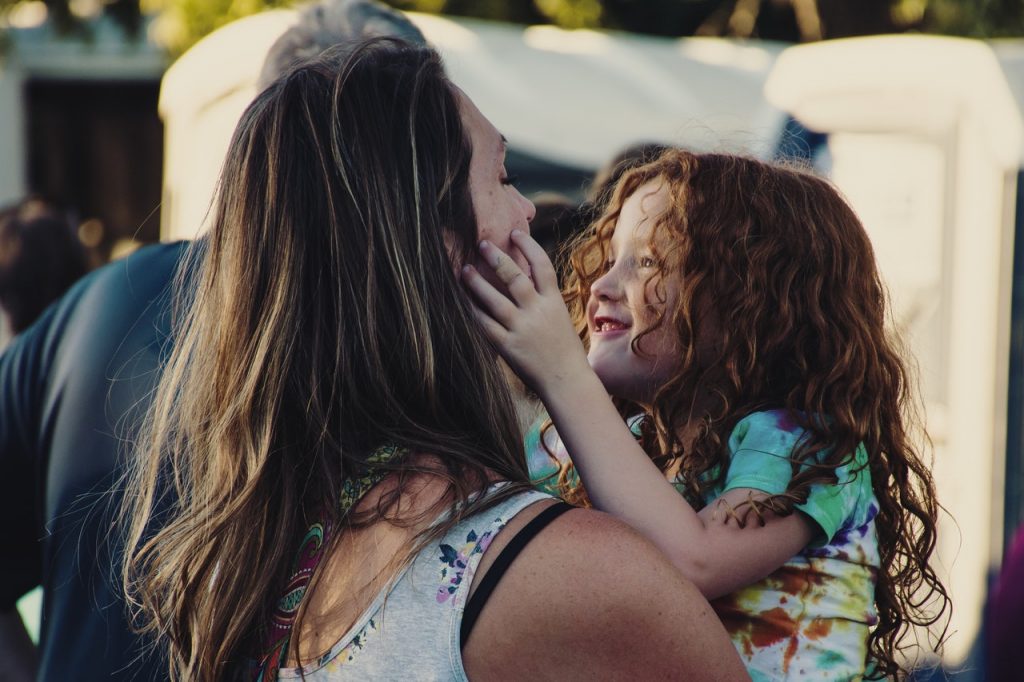
Prostock-studio/Shutterstock.com
When children are riding the bicycle, they pay attention to all of its details. They are interested in everything: how and why pedals turn, why is a handlebar necessary and what happens when it turns. Do not miss the right moment, be sure to use the interest of the child to kick start the learning process. On a tricycle, it is possible to firstly drive around the apartment, and only then to go outside on the street.
Explain the principle of steering right away. Clearly demonstrate that when the steering wheel rotates, the direction of movement changes. Put the child on the saddle and allow them to drive a couple of meters, pushing off with their feet. After that, place their legs on the pedals and talk about their purpose.
On the one hand, there is nothing difficult in explaining about the handlebar and the pedals, but on the other, it could be a pretty nerve-racking process. Little kids find it hard to concentrate. It is difficult to capture their attention, and even more so, to ensure that they are engaged for a certain period of time. In order to ensure their interest in the new type of transportation, ride their favorite toy around. Do not demand everything at once from your child. Move from one stage of training to another in a gradual manner. Until the baby learns to ride the bike, they do not necessarily need to pedal. But as soon as this happens, show them how the pedals work:
- Have the front wheel placed at a slightly elevated position.
- Place the child’s feet on the pedals.
- Turn the pedals with your hands a couple of times.
A few of such movements will instill a true interest in the child. They will try to turn the pedals on their own.
How to teach the child to ride a two-wheel bicycle?
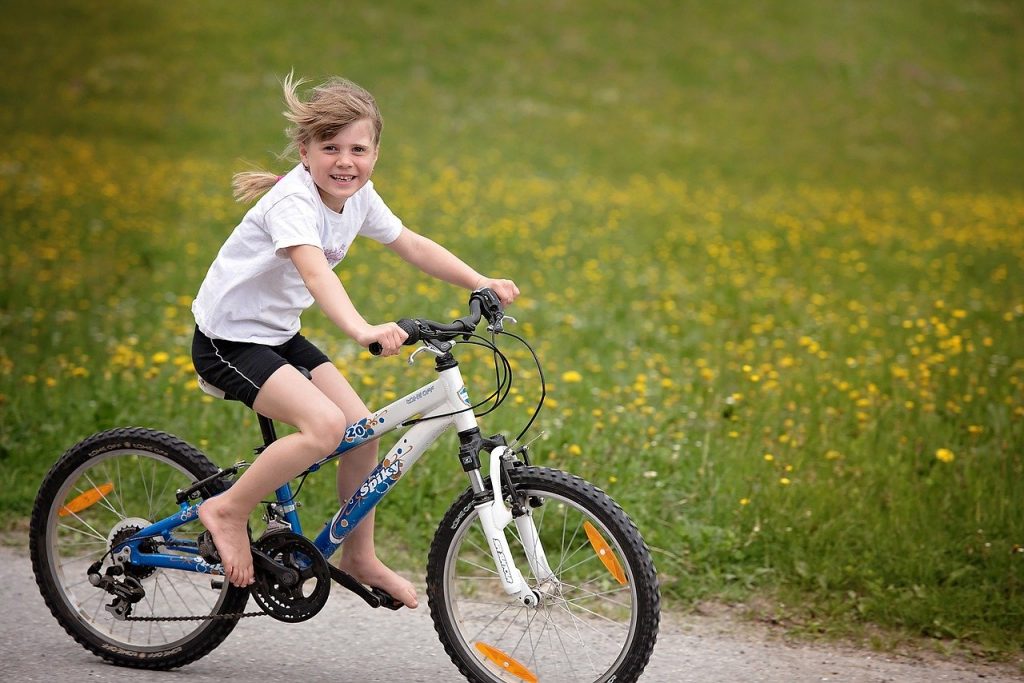
Prostock-studio/Shutterstock.com
Novice cyclists move away from the three-wheeled bicycle at around the age of 5 years old. Riding a miniature copy of an adult bicycle is an option for children who are not grown up enough, to go on a full-sized version. If their muscles have gained in strength, they gained control over the bike and the three-wheeled model started feeling ‘too small’ for them, it is time to buy a two-wheeled bicycle equipped with training wheels.
Is it worth starting with the four-wheel bicycle?
An additional pair of side wheels gives stability and enables a safer movement. Children’s bicycles are sold with training wheels. If they are not provided in the set, they may be purchased separately.
The four-wheeled model is used for a transition between a three-wheeled bicycle and a two-wheeled one. This has both their supporters and opponents. Its main task is to protect the bike from tipping over, and not to teach to maintain balance. When titling over to one side, the emphasis is placed on the side wheels, therefore, the child does not have the opportunity to learn to maintain balance. This is where both the advantage and the disadvantage of a four-wheeled bicycle lies.
From one perspective, it is easier for a child to manage such a model, and on the other hand, it is difficult to refuse an extra safety feature. When the time to remove the training wheels comes, they may be fearful.
Keep the following in mind:
- do not place the training wheels on the same level as the back wheel;
- fix them 1-1,5cm above the ground;
- adjust the wheels and move them up gradually. The child does not have to know about that. In order for them not to get scared, keep it all in secret. When the time comes, tell them about your manoeuvers. Show them that they can already ride without the extra safety, so the training wheels are no longer needed.
Praise your child more often, so that they know that they can do it.
How to teach your child to maintain balance?

Prostock-studio/Shutterstock.com
Start teaching the child little by little — train your child to ride without pedals, by pushing themselves off the ground. A similar procedure needs to be carried out on the balance bicycle:
- the child needs to sit;
- hold the handlebar;
- push themselves against the ground;
- ride for 2-3 meters with their feet lifted off the ground.
It’s easier to maintain balance when you are not thinking about pedals. When falling onto the side, it is necessary to quickly place feet on the ground. After an hour-long training without pedaling, teach them to keep balance while pedaling simultaneously.
Balance is one of the three basic skills in cycling. To teach this while teaching to pedal, stick to the following plan:
- Explain how to get on and off the bike.
- Let your child sit comfortably in the seat, and then tilt the bike in different directions so that they can alternate between the feet that they place on the ground. This way, they can use the feet for support and prevent a fall.
- Offer your child to place their feet on the pedals. Hold your child instead of the bicycle. When it starts tilting over, tell them to step on their foot.
- Explain the functions of the brake. Very often, children do not use the foot brake, due to which there are numerous injuries, which leads to the fear of riding. It is easier for them to jump off the seat and stop with their feet than to apply the brake. The handbrake is also undesirable for beginners because they may accidentally touch it while driving.
- Take the bike with your child and let them hit the brakes. The moment they touch the brake pedal, let go with the bicycle. The toddler must learn to apply the brake and then lean on their foot to be able to stop.
- The process of learning how to pedal is carried out after it has been learned how to stop and confidently hit the brake. Firstly, they need to hold the bicycle throughout the ride. After that, let the child pedal and brake, pushing the bike away at a short distance. Always remain alert if your child has difficulty in braking, you must have enough time to catch them.
- Give them the freedom of action – arrange a small test. Invite the child to sit down, pedal a few meters, brake, and rest their foot on the ground. Choose the flat part of the road or a small hill on which they could perform the entire sequence of actions.
Don’t forget to look out for your children and to encourage them. Do not scold them for mistakes, and praise them only if it is justified. The child should feel your support.
How to teach your child to pedal?
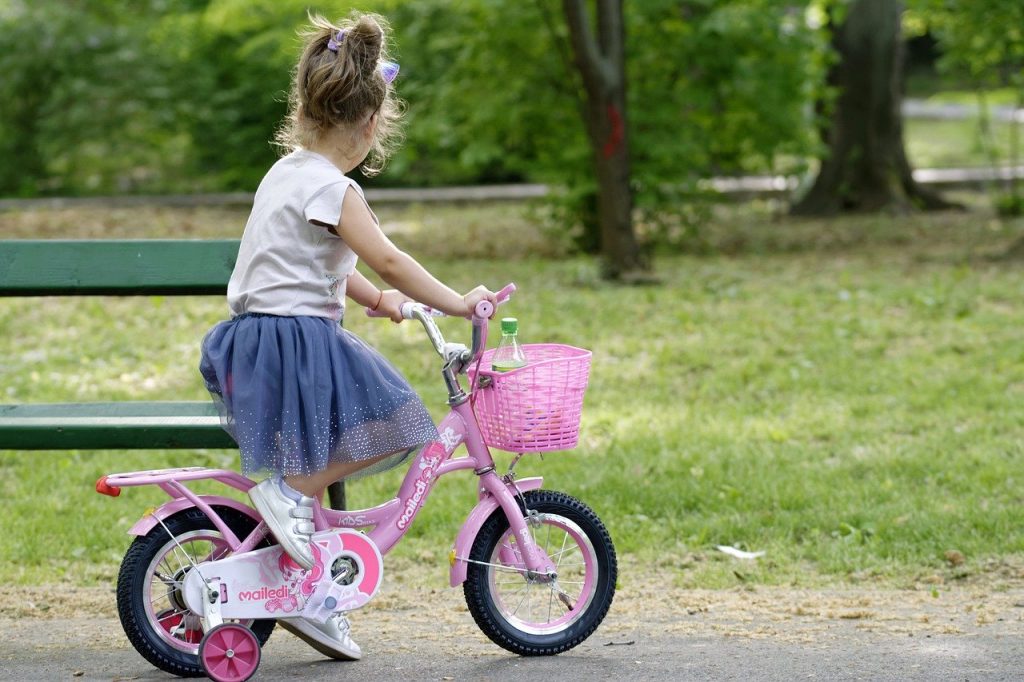
Prostock-studio/Shutterstock.com
You might be thinking, what is so special about that? Nevertheless, your child will show you what the problem is with the pedals. Only a few children agree to pedal starting from the first time. Children refuse to place their feet on them, and this annoys their parents. Experienced coaches advise tying the legs to the pedals so that the rioting child has no chance of jumping off the bike. It may be possible in the case of a tricycle, with parental support and when riding around the room, despite sounding quite brutal. But this would certainly not work with a two-wheeled bicycle. This may also discourage the child from cycling for a lifetime.
Parents who have passed the tricycle test, already know how the beginner cyclist was reacting, and how they began to pedal. However, if you missed the balance bike or tricycle steps, then the first thing to do is to explain to the child that when the pedals are turning, the bike is moving forward.
After that, assist the novice cyclist to sit on the saddle correctly and to pedal in the following ways:
- With their fully extended leg, they need to reach the pedal that is located at the lowest position. The center of the foot should press on the pedal, and not the toe.
- They need to sit on the saddle.
- The other foot should be placed on the pedal, which is in the upper position, and pressed on it. When it lowers, have them repeat the rotational movement with the other leg.
Dad or mom must hold the bike during the exercise. Continue the training until the child learns to find the foot pedal quickly and by touch. Make sure that they place their feet correctly. Pedaling with the toe leads to the feet jumping off the pedal, and, as a consequence, to a sharp stop and fall.
How to teach the child to use the brakes on the bicycle?
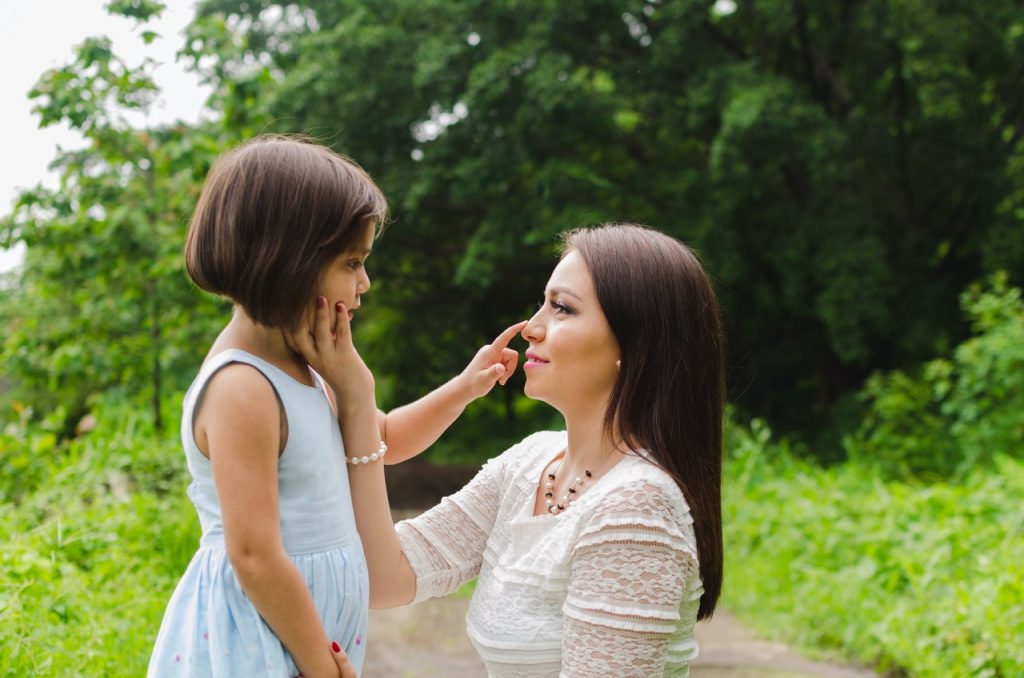
Prostock-studio/Shutterstock.com
Braking is the third skill that cannot be neglected while riding. Perhaps the child will not learn how to stop right away. Do not be discouraged, as not even all adults know how to brake properly, therefore, it is not correct to demand this from children.
Ideally, the cyclist should use both the front and rear brakes, with the front one being used 2 out of 3 times, and the rear one – 1 out of 3. Only more experienced cyclists can distribute the effort correctly and master this technique. A beginner may strive for this, however, most importantly, they need to be taught the basics of safe braking. To make the process part of tacit knowledge, use the two following techniques with your child:
- Draw a line on the ground. This will be the finish line – the area in front of which they need to brake and lean on the foot that has been removed from the pedal. Increase your speed to teach your child to stop when driving both quickly and slowly.
- Improve their reaction. Give your child the freedom of action by marking the borders of the riding area. Agree that at the “Stop!” signal, they should immediately hit the brake and place their feet on the ground, and on with “Forward!”, they can start moving.
Carry out the training sessions in a playful manner so that interest in the process does not become lost, but also so that there is no sensation of constant testing. It is better to start them when the first two skills have already been mastered, when the young cyclist knows how to maintain balance and has already learned how to pedal. Take the time to develop the skill of reaction. These 2 exercises will help to react to the situation on the road, and then allow to quickly brake at traffic lights and intersections.
How to protect the child from injuries?
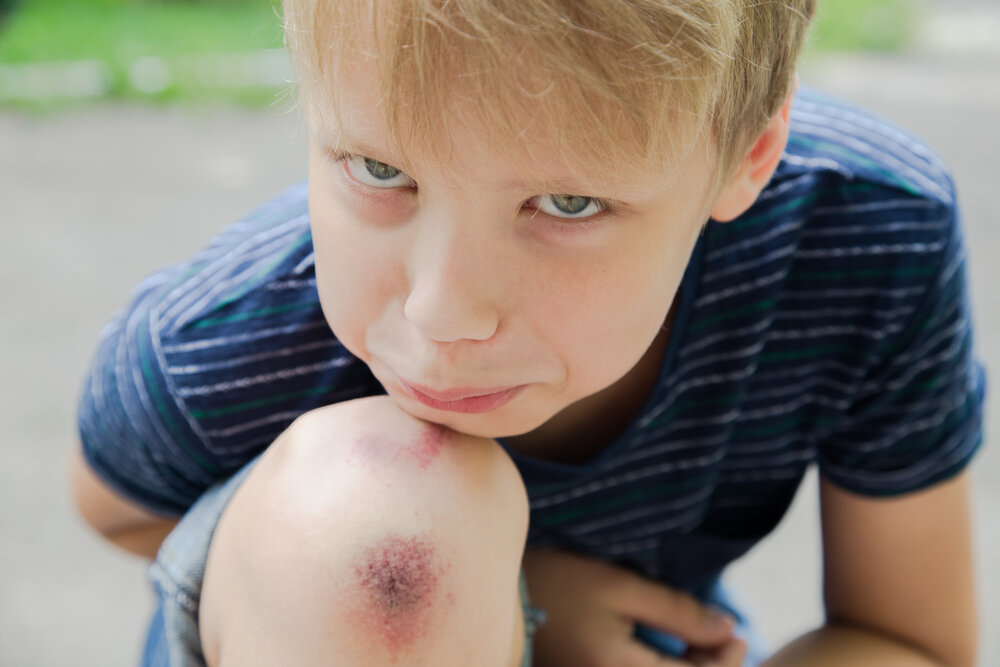
Prostock-studio/Shutterstock.com
Riding the bicycle may be traumatic. Falls will eventually happen and this is normal. In order to protect your little one from injuries, ensure that they have got the following:
- a helmet;
- a set of protective knee pads and elbow pieces;
- gloves with cut out finger parts (if desired).
The equipment will be useful for children that are not very stable on the road and that have trouble controlling the steering of the bike.
Choose the protection kit to fit the size. Buy a helmet that fits with regards to the circumference of the head. Choose a lightweight, but a durable and child-friendly model. Also, pay attention to footwear. It is not allowed to ride barefoot, and sandals and slippers do not provide sufficient traction.
Safety measures
Traffic rules are the basis to which beginner cyclists are introduced to be able to ride without adult supervision. Explain the rules of behavior on the road and talk about respect for other participants in road circulation. Create a set itinerary based on which it is possible to drive from your home to the nearest park safely. Walk through it with the child, focusing on sections with busy traffic.
Dangerous routes and falls from a bicycle are not the only dangers for a child. Parents need to be particularly vigilant during the summer holidays. We suggest reading our article on Summer safety for children to learn more on the matter, to be alert and to pass on this information to your children.
Are there any alternative teaching methods?
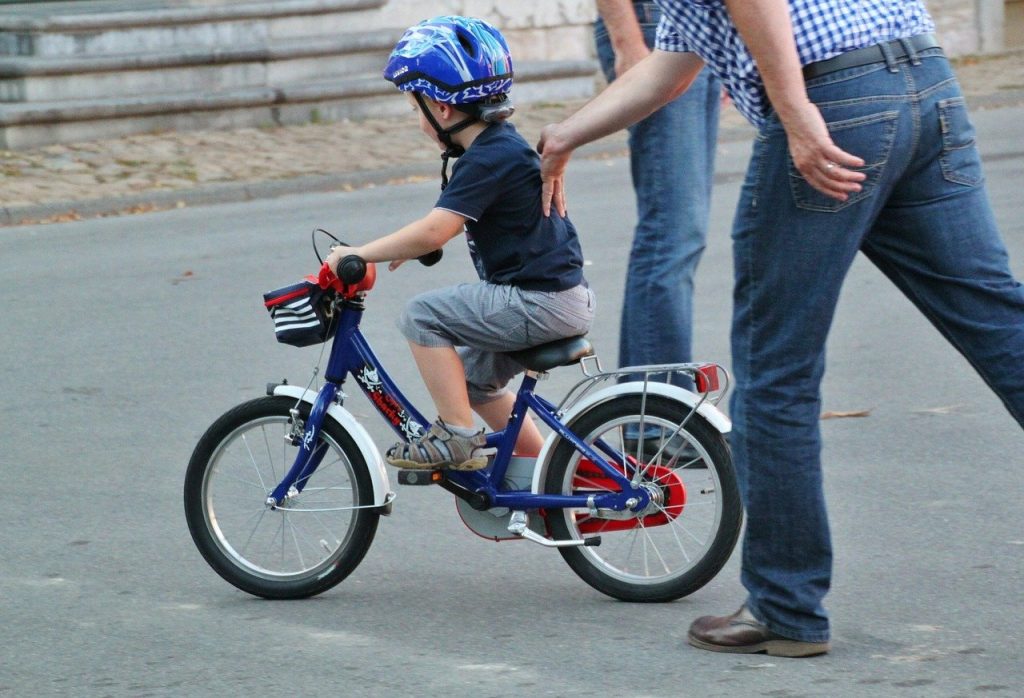
Prostock-studio/Shutterstock.com
The principle of training is the same, the difference lies solely in the approach. You, as a parent, know how to engage your child. Riding the bike is to be broken down into the following steps:
- maintaining balance;
- pedaling;
- braking;
- riding with the help of children;
- riding in autonomy.
A quick method to teach a right-handed child:
- Place the bicycle to the right of the child.
- Let them take the handlebar and drive the bike, turning to the left and to the right. Hold the bicycle, but not too firmly, to enable the child to learn to turn it on their own.
- After that, they should hold on to the seat with their right hand, and the handlebar with their left hand.
- Have the child stand on the pedal with one foot – to place the right foot on the left pedal, standing to the left of the bicycle. The experience will be similar to riding a scooter, because it would be necessary to push off the ground.
- Come closer to the pavement. Have the child place one foot on it and the other one – on the pedal which is located on the other side of the frame and the highest point.
- Have the child push away from the pavement, press on the pedal and start riding.
Training a left-handed child differs in terms of the position of the bicycle near the child. Move from one activity to another after the child overcomes their fear and copes with the task.
Where can children of different ages ride?
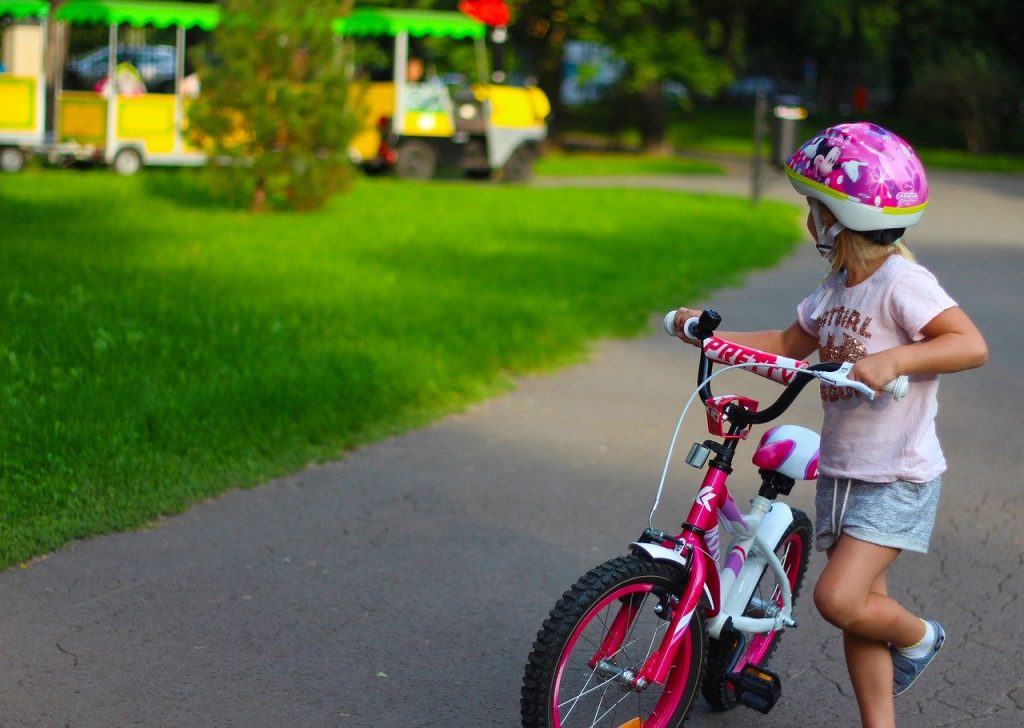
Prostock-studio/Shutterstock.com
The place for training and subsequent cycling should be smooth, with enough light, without cars and without direct access to the roadway. The road can be of either asphalt or dirt. It’s easier to ride on asphalt, however, falling on the lawn is much less painful.
Note that children under the age of 7 years old can only ride under parental control. From 7 to 13 years old, they can ride in the park area and on bike paths. 14-year-old teenagers can cycle along city roads in the same way as adults.
Keep a peace of mind for your child during bicycle rides and walks on the streets, in parks and in forests. Know where your child is at all times and which pathway they took with the “Findmykids” app available on AppStore and GooglePlay.
Tips for parents
Do not buy the means of transport ‘for the years to come’ and for future usage. Choose it according to height and not age. Adjust the height of the front set and the saddle. Ensure your child has got the necessary protective equipment.
Read the step-by-step instruction and learn how and which bicycle to choose for the child.
Before putting the baby on a bicycle, choose the appropriate transport and help them to get rid of fear. Start with a tricycle and then teach them to ride a two-wheeled bike. Use the training wheels to prevent falls. Teach everything step-by-step: from the ability to maintain balance to the abrupt braking at high speed. Find a special approach for the child, support them and repeat all exercises several times.
Проверьте электронный ящик



















